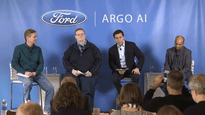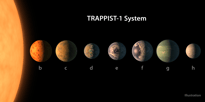
In this week's Abundance Insider: Washable smartphone, time crystals and Ford’s $1B AI bet.
Cheers,
Peter, Marissa, Cody, Kelley, Greg, Sydney and AJ
P.S. For those with a tie to production, I recommend attending Exponential Manufacturing in Boston May 17th-19th. This Singularity University Summit will bring together 600+ leading innovators from Fortune 500s and startups alike, to answer questions such as: How will artificial intelligence and robotics impact the workforce? How will additive manufacturing fit into the mainstream economy? How will machine learning drive your supply chain? How do you get a large organization to pivot with the speed of a startup? Save up to 15% as a PHD community member. For those in the financial field, this offer is good for Exponential Finance too. First-Mover pricing on both ends March 1st.
Nanorods Emit and Detect Light, Could Lead to Displays That Communicate via Li-Fi

What it is: A team of researchers from the University of Illinois at Urbana-Champaign, the Electronics and Telecommunications Research Institute in South Korea, and Dow Chemical joined together to produce a nanorod-based LED pixel capable of emitting and detecting light. To produce these engineered nanorods, the researchers mixed three types of semiconductors: one is the quantum dot that emits and absorbs visible light, and two are the rod's main body and shell surrounding the quantum dot. Due to the fast response time of this nanorod-based LED pixel, nanorods have the potential to open up a host of new display capabilities, such as visible light communication and self-powered displays.
Why it's important: These dual-functioning diodes open feasible routes to a variety of advanced applications, from touchless interactive screens, energy-harvesting displays, and interactive displays that are as easy to design and manufacture as traditional displays. | Join the Discussion
Spotted by Gaetan Soltesz / Written by Sydney Fulkerson
Ford is Putting $1 Billion Into An Artificial Intelligence Startup

What it is: In the largest investment by a Detroit car company to date, Ford has invested over $1 billion to acquire a majority stake in Argo AI, an artificial intelligence startup focused on self-driving vehicles. Founded by former executives from Google, Uber and Carnegie Mellon, Argo AI will continue to operate as a startup -- in part because of the agility that structure brings, but also because it retains the ability to attract top talent with its culture and equity incentives. Interestingly, while Ford plans to release fully autonomous vehicles by 2021, they also see a lot of winners in the new market, and expect that Argo AI will license its software to non-direct competitors.
Why it's important: We are full steam ahead to an autonomous vehicle future, shared or owned. As Ford seems to acknowledge in wanting to license the Argo software, car companies must transform to survive, and the most valuable assets in this new world seem to be talent, software and data. By the same token, startups like Argo also need the scaling prowess of a large company like Ford to fully realize their commercial potential. In the short term, expect a more diverse ecosystem to emerge in the auto industry. Longer term, autonomous vehicles are inevitable. What cultural shifts will occur when transportation becomes a utility rather than a consumer good or status symbol? | Join the Discussion
Spotted by Cody Rapp / Written by Jason Goodwin
Kyocera Introduces New Washable Smartphone in Japan

What it is: Kyocera recently introduced a hot-water-resistant, washable smartphone with a touchscreen that can even be used when hands are wet or while wearing gloves. Its previous model, DIGNO rafre, was the world's first hand-soap-washable smartphone when it launched in December 2015. This new "rafre" is equipped with phase detection autofocus and auto HDR, a 13-megapixel rear camera, 2GB of RAM, 16GB of internal memory and runs on Android 7.0 Nougat OS. The phone is expected to hit the Japanese market in March 2017.
Why it's important: Mobile devices are quickly becoming ubiquitous, but not all smartphones stand up to real-world bumps, spills and drops. By leveraging materials science and intelligent design for its DIGNO rafre smartphone, Kyocera addresses an underserved market of buyers who want durable, "life-resistant" devices. | Join the Discussion
Spotted by Aryadeep S. Acharya / Written by Sydney Fulkerson and Marissa Brassfield
Breakthrough with 3D Printed Gas Turbine Blades

What it is: Siemens engineers have taken additive manufacturing to a new level, creating 3D printed gas turbine blades for use in power generation that, in a world first, have successfully passed full-load testing. By directing a laser beam at fine layers of powdered polycrystalline nickel-based superalloy, the team created blades capable of meeting the demanding environment of gas turbines, in which the blades may rotate as fast as 1,000 mph and bear as much as 11 tons -- all at temperatures exceeding 1250 degrees Celsius. End to end, additive manufacturing has reduced the time Siemens takes to develop, test, and produce new designs by 90%.
Why it's important: Gas turbines are massive, must withstand harsh environments, and are quite intricate in their aerodynamics and cooling properties. As we saw from Autodesk at Abundance 360 this year, even bigger breakthroughs will emerge when larger 3D printing projects like these incorporate AI and generative design. | Join the Discussion
Spotted by Lorne Deyenberg / Written by Jason Goodwin
These "Smart Glasses" Adjust to Your Vision Automatically
What it is: Researchers at the University of Utah recently developed "smart glasses" that adjust focus automatically -- and they could hit the market in two to three years. Created using liquid lenses, objects in front of the person wearing them show up clear, no matter his or her distance from the object. Unlike regular prescription glasses, which only shift range of what's in focus, these new smart glasses use a clear liquid called glycerin enclosed in a flexible membrane that changes the curvature of the glycerin lens. Using infrared light, a distance meter on the bridge measures the distance from the wearer's face to nearby objects -- sending a signal to adjust the curve of the lens, which enables focus from one object to adjust to another in just 14 milliseconds. The researchers' next endeavor is to reduce the product's weight and thickness.
Why it's important: These smart glasses could disrupt prescription eyewear as we know it today -- a large market, considering just 35% of the population has 20/20 vision. The convergence of materials science and technology, plus features like auto-adjustments and an integrated smartphone app, enable an incredibly accurate, convenient and customized consumer experience. As this technology demonetizes and democratizes, and other cutting-edge vision-correcting solutions come to market, we'll eventually eradicate the impact of poor eyesight, macular degeneration and blindness. | Join the Discussion
Spotted by Adrienne Lee / Written by Sydney Fulkerson and Marissa Brassfield
Scientists Have Confirmed a Brand New Phase of Matter: Time Crystals

What it is: Norman Yao at UC Berkeley and his team have experimentally proven a new form of matter, time crystals, which were theoretically identified by Nobel Laureate Frank Wilczek in 2012. Unlike most forms of matter, which are stable and rigid in space at their lowest energy or ground state, time crystals oscillate in time, changing shape on a set interval.
Why it's important: While the immediate applications are not apparent, the confirmation indicates possible larger breakthroughs in the near future. For starters, this discovery implies that time and matter are more closely linked than quantum mechanics currently allows, which is one reason Albert Einstein felt quantum mechanics was incomplete. In theory, time crystals take us a step closer to unifying general relativity and quantum mechanics -- and who knows what could spring up from a more elegant encapsulation of the universe. Previous advances in fundamental physics, materials science, and high speed computing are part of the process that enabled Yao to experimentally confirm the existence of time crystals. Look for even more scientific breakthroughs as our tools of discovery continue to improve exponentially. | Join the Discussion
Spotted by Gaetan Soltesz / Written by Jason Goodwin
New Leaf Helps Canada's Newly Homeless

What it is: Competing for Google's Impact Challenge (and the $750,000 prize), Vancouver non-profit the New Leaf Project has launched a pilot designed to disrupt the cycle of homelessness at the moment an individual's life starts to spin out of control. Awarding a one-time cash grant of $7,500 to help them get their lives back on track, this approach is based on evidence from other direct cash transfer projects. One such project, the London Rough Sleepers Study, helped 11 of 13 homeless individuals gain housing and reclaim their lives after a receiving a personalized budget of £3,000. (Editor's Note: New Leaf Project has two ties to Abundance 360 -- founder and chairman Frans Tjallingii and board member Colin Mansell are A360 members.)
Why it's important: Canadian costs for homelessness programs are at record heights at almost $7 billion annually. The New Leaf Project and direct cash transfer projects disrupt these traditional approaches to one of society's more intractable problems, both reducing cost and increasing efficacy. Considering the experiments on Universal Basic Income throughout the world, we're seeing an important shift in our global mindset to solving grand social challenges and redefining the role of government. | Join the Discussion
Spotted by Frans Tjallingii / Written by Jason Goodwin
NASA Telescope Reveals Largest Batch of Earth-Size, Habitable-Zone Planets Around Single Star

What it is: NASA's Spitzer Space Telescope recently revealed seven Earth-sized planets around a single star. Of the seven, three are habitable-zone planets -- although all seven could have liquid water. This discovery sets the record for the largest batch of habitable-zone planets outside our solar system (classified as exoplanets). This group of exoplanets is called TRAPPIST-1, short for The Transiting Planets and Planetesimals Small Telescope (TRAPPIST).
Why it's important: We are in a new "race to space," and this discovery is a major step forward in the hunt for habitable environments. What else will we learn about our solar system as space researchers have increasingly better and more powerful technologies at their disposal? | Join the Discussion
Spotted by Marissa Brassfield / Written by Sydney Fulkerson
What is Abundance Insider?
This email is a briefing of the week's most compelling, abundance-enabling tech developments, curated by Marissa Brassfield in preparation for Abundance 360. Read more about A360 below.
WANT MORE CONVERSATIONS LIKE THIS?
At Abundance 360, Peter's 360-person executive mastermind, we teach the metatrends, implications and unfair advantages for entrepreneurs enabled by breakthroughs like those featured above. We're looking for CEOs and entrepreneurs who want to change the world. The program is highly selective. Apply now for Abundance360 Summit if you'd like to develop an Abundance Mindset.
Know someone who would benefit from getting Abundance Insider? Send them to this link to sign up.







